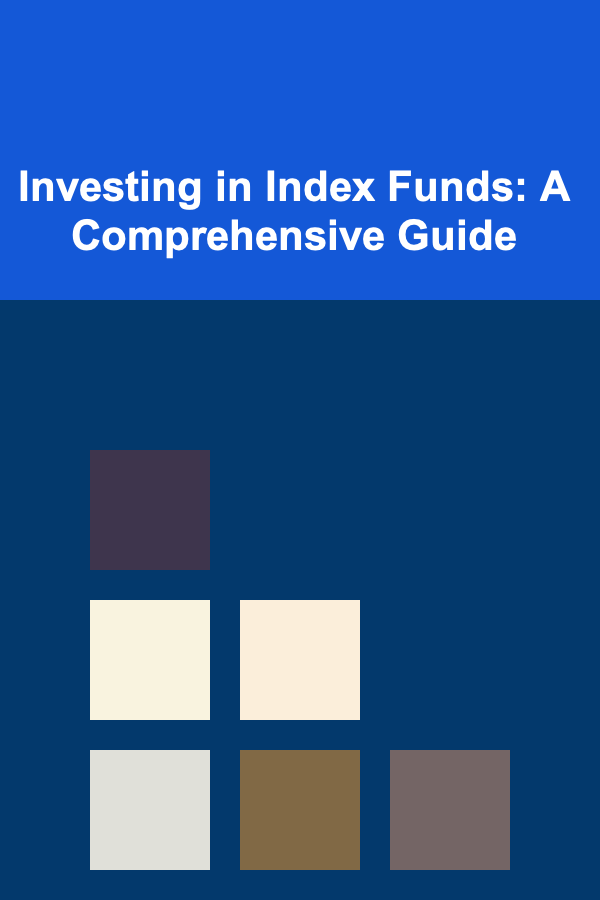
Investing in Index Funds: A Comprehensive Guide
ebook include PDF & Audio bundle (Micro Guide)
$12.99$7.99
Limited Time Offer! Order within the next:

Index funds have become a cornerstone of modern investing, offering a simple and effective way to participate in the market's overall growth. Their popularity stems from their low cost, diversification, and relatively predictable performance. This comprehensive guide will delve into the intricacies of index fund investing, covering everything from the fundamental principles to advanced strategies. Whether you're a novice investor just starting out or an experienced market participant looking to refine your portfolio, this guide will provide valuable insights to help you make informed decisions.
What are Index Funds?
At its core, an index fund is a type of mutual fund or exchange-traded fund (ETF) that aims to mirror the performance of a specific market index. This index, such as the S&P 500, the Nasdaq 100, or the Russell 2000, represents a basket of securities designed to reflect a particular segment of the market. Instead of trying to "beat" the market through active management, index funds passively track the index's composition, holding the same securities in roughly the same proportions.
This passive approach has several key implications:
- Lower Fees: Because index funds don't require a team of analysts and portfolio managers actively researching and selecting investments, their operating expenses are significantly lower than actively managed funds. These lower fees translate directly into higher returns for investors over the long term.
- Diversification: Index funds provide instant diversification across a broad range of securities, reducing the risk associated with investing in individual stocks or bonds. For example, an S&P 500 index fund will hold shares of 500 of the largest publicly traded companies in the United States, effectively spreading your investment across a significant portion of the US economy.
- Transparency: The holdings of an index fund are typically transparent, meaning investors can easily see which securities the fund owns. This transparency allows investors to understand exactly what they are investing in and assess the fund's overall risk profile.
- Predictable Performance: While no investment is completely risk-free, the performance of an index fund is generally more predictable than that of an actively managed fund. Because the fund simply tracks a pre-defined index, its returns will closely mirror the performance of that index, minus expenses. This predictability can be beneficial for investors who prefer a more hands-off and predictable investment approach.
Mutual Funds vs. ETFs: Index Fund Options
Index funds are available in two main formats: mutual funds and exchange-traded funds (ETFs). While both types of funds track market indexes, they have some key differences that can impact their suitability for different investors.
- Mutual Funds: Index mutual funds are purchased directly from the fund company or through a brokerage account. Shares are typically bought and sold at the end of the trading day, based on the fund's net asset value (NAV). Mutual funds often have minimum investment requirements and may not be as tax-efficient as ETFs.
- ETFs: Index ETFs trade on stock exchanges like individual stocks. Shares can be bought and sold throughout the trading day at market prices, which may fluctuate slightly above or below the fund's NAV. ETFs generally have lower expense ratios than mutual funds and are often more tax-efficient due to their structure. However, ETFs may incur brokerage commissions each time they are bought or sold.
The choice between index mutual funds and index ETFs depends on individual preferences and investment strategies. ETFs offer greater trading flexibility and potential tax advantages, while mutual funds may be simpler for investors who prefer to invest regularly and avoid the complexities of trading on an exchange.
Why Invest in Index Funds?
The appeal of index funds lies in their ability to deliver market-like returns at a low cost. Several factors contribute to their popularity:
- Cost Efficiency: As mentioned earlier, index funds have significantly lower expense ratios than actively managed funds. These lower costs can have a substantial impact on long-term returns, as even a seemingly small difference in expense ratio can compound over time. Research consistently shows that low-cost index funds outperform actively managed funds over the long run, primarily due to the cost advantage.
- Diversification Benefits: Index funds offer instant diversification across a wide range of securities, reducing the risk associated with investing in individual stocks or bonds. This diversification can help to smooth out returns and protect your portfolio from significant losses during market downturns.
- Simplicity and Ease of Use: Index funds are relatively simple to understand and invest in. You don't need to spend hours researching individual companies or trying to predict market trends. Simply choose an index fund that tracks a market index that aligns with your investment goals and risk tolerance, and you're on your way.
- Tax Efficiency: Index funds tend to have lower turnover rates than actively managed funds, meaning they buy and sell securities less frequently. This lower turnover can result in fewer taxable capital gains distributions, making index funds more tax-efficient than actively managed funds.
- Market Exposure: Index funds provide broad exposure to the overall market or specific segments of the market. This allows investors to participate in the long-term growth potential of the economy without having to pick individual winners and losers.
While index funds offer numerous advantages, it's important to acknowledge their limitations. Index funds will only ever match the performance of their underlying index, meaning they will never outperform the market. Also, during periods of rapid market growth, some actively managed funds may outperform index funds, although this is rarely sustainable over the long term.
How to Choose the Right Index Funds
Selecting the appropriate index funds for your portfolio requires careful consideration of your investment goals, risk tolerance, and time horizon. Here's a step-by-step guide to help you navigate the selection process:
1. Define Your Investment Goals
Before you start investing, it's essential to define your investment goals. What are you saving for? When will you need the money? Are you saving for retirement, a down payment on a house, your children's education, or something else? The answers to these questions will help you determine your investment time horizon and risk tolerance.
2. Assess Your Risk Tolerance
Risk tolerance refers to your ability and willingness to withstand potential losses in your investments. If you're comfortable with the possibility of experiencing short-term losses in exchange for the potential for higher long-term returns, you may have a higher risk tolerance. If you're more concerned about preserving capital and avoiding losses, you may have a lower risk tolerance.
Consider the following factors when assessing your risk tolerance:
- Time Horizon: The longer your time horizon, the more risk you can generally afford to take. If you have many years until you need the money, you have more time to recover from potential losses.
- Financial Situation: Your financial stability and income level can also influence your risk tolerance. If you have a stable income and a comfortable financial cushion, you may be more willing to take on riskier investments.
- Psychological Factors: Your emotional reaction to market fluctuations is also an important consideration. If you tend to panic and sell your investments during market downturns, you may have a lower risk tolerance.
3. Select a Market Index
Once you've defined your investment goals and assessed your risk tolerance, you can begin to select market indexes that align with your objectives. There are a wide variety of indexes to choose from, each representing a different segment of the market.
Here are some of the most popular market indexes:
- S&P 500: Tracks the performance of 500 of the largest publicly traded companies in the United States. A broad market index that provides exposure to a significant portion of the US economy.
- Nasdaq 100: Tracks the performance of 100 of the largest non-financial companies listed on the Nasdaq Stock Market. Heavily weighted towards technology companies.
- Russell 2000: Tracks the performance of 2,000 small-cap companies in the United States. Provides exposure to a different segment of the market than the S&P 500 and Nasdaq 100.
- Dow Jones Industrial Average (DJIA): Tracks the performance of 30 large, publicly owned companies based in the United States. Price-weighted index, meaning companies with higher share prices have a greater impact on the index's performance.
- MSCI EAFE: Tracks the performance of large and mid-cap companies in developed countries outside of the United States and Canada. Provides exposure to international markets.
- Bloomberg Barclays U.S. Aggregate Bond Index: Tracks the performance of U.S. investment-grade bonds.
4. Evaluate Index Funds
After selecting a market index, you'll need to evaluate the index funds that track that index. Consider the following factors:
- Expense Ratio: The expense ratio is the annual fee charged by the fund to cover its operating expenses. Look for index funds with low expense ratios, as this will have a significant impact on your long-term returns. Generally, aim for expense ratios below 0.10% for broad market index funds.
- Tracking Error: Tracking error measures how closely the fund's performance matches the performance of its underlying index. A lower tracking error indicates that the fund is more effectively tracking the index. While some tracking error is inevitable, look for funds with consistently low tracking errors.
- Liquidity: Liquidity refers to the ease with which you can buy and sell shares of the fund. ETFs generally have higher liquidity than mutual funds, as they trade on stock exchanges throughout the day.
- Fund Size: A larger fund size can indicate greater stability and liquidity. However, very large funds may experience some difficulty in accurately tracking their underlying index.
- Underlying Index Methodology: Understand how the underlying index is constructed. Is it market-cap weighted, equally weighted, or use another methodology? Market-cap weighting is the most common, where larger companies have a bigger influence on the index.
5. Diversify Your Portfolio
Don't put all your eggs in one basket. Diversification is key to managing risk and maximizing long-term returns. Create a well-diversified portfolio by investing in a mix of different asset classes, such as stocks, bonds, and real estate. Within your stock allocation, diversify across different market segments, such as large-cap, mid-cap, small-cap, and international stocks. You can achieve this diversification using a combination of different index funds.
A common asset allocation strategy is to allocate a higher percentage of your portfolio to stocks when you are younger and have a longer time horizon, and gradually shift towards a more conservative allocation with a higher percentage of bonds as you get closer to retirement.
Where to Buy Index Funds
Index funds are widely available through various investment platforms:
- Online Brokers: Online brokers such as Vanguard, Fidelity, Charles Schwab, Interactive Brokers, and others offer a wide selection of index funds and ETFs with low or no commission trading. These platforms typically provide research tools and educational resources to help you make informed investment decisions.
- Fund Companies: You can also purchase index funds directly from fund companies like Vanguard and Fidelity. This can be a good option if you prefer to work directly with the fund company and avoid brokerage fees. However, you may have a limited selection of funds to choose from compared to online brokers.
- Robo-Advisors: Robo-advisors such as Betterment and Wealthfront use algorithms to create and manage diversified investment portfolios based on your risk tolerance and financial goals. These platforms typically invest in low-cost index funds and ETFs, making them a convenient option for hands-off investors.
- Financial Advisors: If you prefer to work with a human advisor, you can consult with a financial advisor who can help you develop a personalized investment plan and select appropriate index funds. However, be aware that financial advisors typically charge fees for their services, which can reduce your overall returns. Choose a fee-only advisor to avoid potential conflicts of interest.
Strategies for Investing in Index Funds
Once you've chosen your index funds and opened an account, it's time to implement your investment strategy. Here are some popular strategies for investing in index funds:
Dollar-Cost Averaging
Dollar-cost averaging involves investing a fixed amount of money at regular intervals, regardless of market conditions. This strategy helps to reduce the risk of investing a large sum of money at the "wrong" time and can smooth out your returns over the long term. When prices are low, you'll buy more shares, and when prices are high, you'll buy fewer shares.
Rebalancing
Rebalancing involves periodically adjusting your portfolio to maintain your desired asset allocation. For example, if your target allocation is 60% stocks and 40% bonds, you would rebalance your portfolio when the actual allocation deviates significantly from this target. This helps to ensure that you're not taking on too much or too little risk and can also help to improve your long-term returns.
Tax-Loss Harvesting
Tax-loss harvesting involves selling investments that have lost value to offset capital gains taxes. This strategy can help to reduce your overall tax burden and improve your after-tax returns. However, be aware of the wash-sale rule, which prohibits you from repurchasing a substantially identical security within 30 days of selling it for a loss.
Buy and Hold
A buy and hold strategy is a long-term investment approach where you purchase index funds and hold them for an extended period, regardless of market fluctuations. This strategy is based on the belief that the market will generally trend upwards over the long run, and that trying to time the market is a futile exercise. It's crucial to have the discipline to weather market volatility and stick to your investment plan.
Common Mistakes to Avoid
Investing in index funds is a relatively straightforward process, but it's still possible to make mistakes. Here are some common mistakes to avoid:
- Chasing Performance: Don't be tempted to chase after the latest "hot" investment. Past performance is not necessarily indicative of future results. Focus on investing in a diversified portfolio of low-cost index funds that align with your long-term goals.
- Market Timing: Trying to time the market is a difficult and often unsuccessful endeavor. It's impossible to consistently predict when the market will go up or down. Instead of trying to time the market, focus on investing regularly and staying invested for the long term.
- Ignoring Fees: Fees can eat into your returns over time. Pay attention to the expense ratios of the index funds you're considering and choose funds with low expense ratios.
- Failing to Rebalance: Failing to rebalance your portfolio can lead to an unbalanced asset allocation and increased risk. Rebalance your portfolio regularly to maintain your desired asset allocation.
- Panicking During Market Downturns: Market downturns are a normal part of investing. Don't panic and sell your investments when the market drops. Instead, view market downturns as an opportunity to buy more shares at lower prices.
- Not Understanding the Underlying Index: Before investing in an index fund, take the time to understand the composition and methodology of the underlying index. This will help you understand the fund's risk profile and how it is likely to perform in different market conditions.
Advanced Strategies
While index fund investing is often viewed as a simple, passive strategy, there are some advanced techniques that investors can use to potentially enhance their returns or manage risk more effectively.
Factor-Based Investing (Smart Beta)
Factor-based investing, also known as smart beta, involves tilting your portfolio towards specific factors that have historically been associated with higher returns, such as value, momentum, quality, and size. These factors are based on academic research that suggests certain characteristics of stocks can lead to outperformance over the long run. Factor-based index funds track indexes that are constructed to emphasize these factors, offering investors a potentially more sophisticated approach to index fund investing.
However, it's important to note that factor-based investing is not a guaranteed path to higher returns. The performance of factor-based funds can vary over time, and there is no guarantee that the factors that have historically been successful will continue to be so in the future. Also, factor investing might mean higher expense ratios. Careful due diligence and a thorough understanding of the underlying factors are essential before investing in factor-based index funds.
Using Index Funds for Asset Allocation
Index funds are an excellent tool for implementing a strategic asset allocation plan. By investing in a combination of different index funds that track various asset classes, such as stocks, bonds, and real estate, investors can create a diversified portfolio that aligns with their risk tolerance and investment goals. This approach allows investors to easily maintain their desired asset allocation over time and benefit from the long-term growth potential of the market.
Dynamic Asset Allocation
Dynamic asset allocation involves adjusting your asset allocation based on market conditions or economic forecasts. This approach is more active than traditional static asset allocation and requires a greater understanding of market dynamics. While dynamic asset allocation has the potential to enhance returns, it also carries a higher risk of making incorrect predictions or reacting emotionally to market fluctuations. It is crucial to base any adjustments on a well-defined investment strategy and avoid making impulsive decisions.
Geographic Diversification
Expanding your index fund investments beyond your home country can provide valuable diversification and access to global growth opportunities. International index funds track indexes that represent companies in developed and emerging markets, allowing investors to participate in the growth of economies around the world. While international investments can offer higher potential returns, they also come with additional risks, such as currency fluctuations and political instability. A well-diversified portfolio should include a mix of domestic and international index funds.
Conclusion
Investing in index funds is a simple, cost-effective, and diversified way to participate in the market's overall growth. By understanding the fundamental principles of index fund investing, choosing the right funds for your portfolio, and implementing a sound investment strategy, you can increase your chances of achieving your long-term financial goals. Remember to focus on the long term, avoid common mistakes, and stay disciplined in your investment approach. While not a get-rich-quick scheme, a consistent and well-thought-out index fund strategy is a powerful tool for building wealth over time. Consider consulting with a qualified financial advisor to develop a personalized investment plan that meets your specific needs and circumstances.
Disclaimer: This guide is for informational purposes only and does not constitute financial advice. Investing involves risk, and you could lose money. Consult with a qualified financial advisor before making any investment decisions.

How to Choose the Best Coffee for Single Origin Brewing
Read More
How to Create Tutorial Videos on YouTube to Show How Your Dropshipping Products Solve Problems
Read More
How to Organize Your Ironing Supplies and Equipment
Read More
How to Set Up a DIY Dessert Station for Your Home Party
Read More
How To Understand Common Dog Health Issues
Read More
How to Fix a Running Toilet: A Comprehensive Guide
Read MoreOther Products

How to Choose the Best Coffee for Single Origin Brewing
Read More
How to Create Tutorial Videos on YouTube to Show How Your Dropshipping Products Solve Problems
Read More
How to Organize Your Ironing Supplies and Equipment
Read More
How to Set Up a DIY Dessert Station for Your Home Party
Read More
How To Understand Common Dog Health Issues
Read More